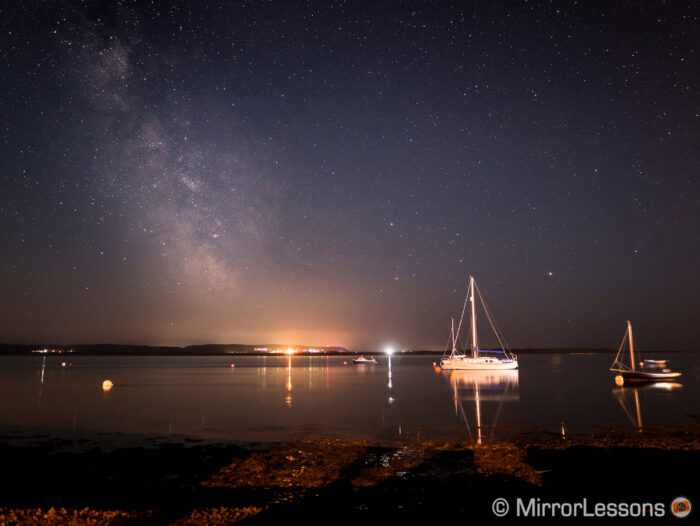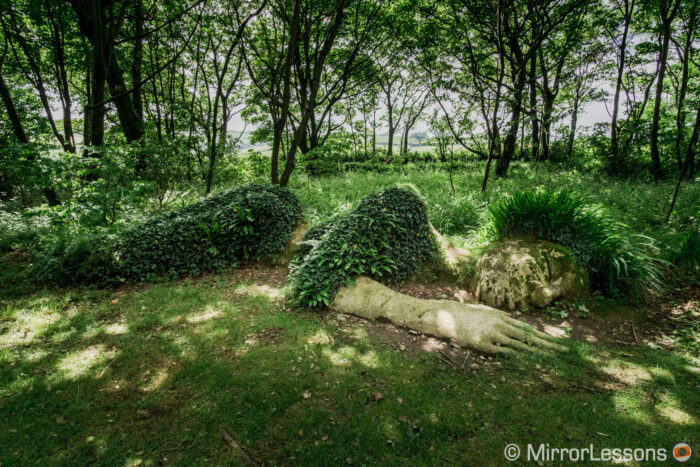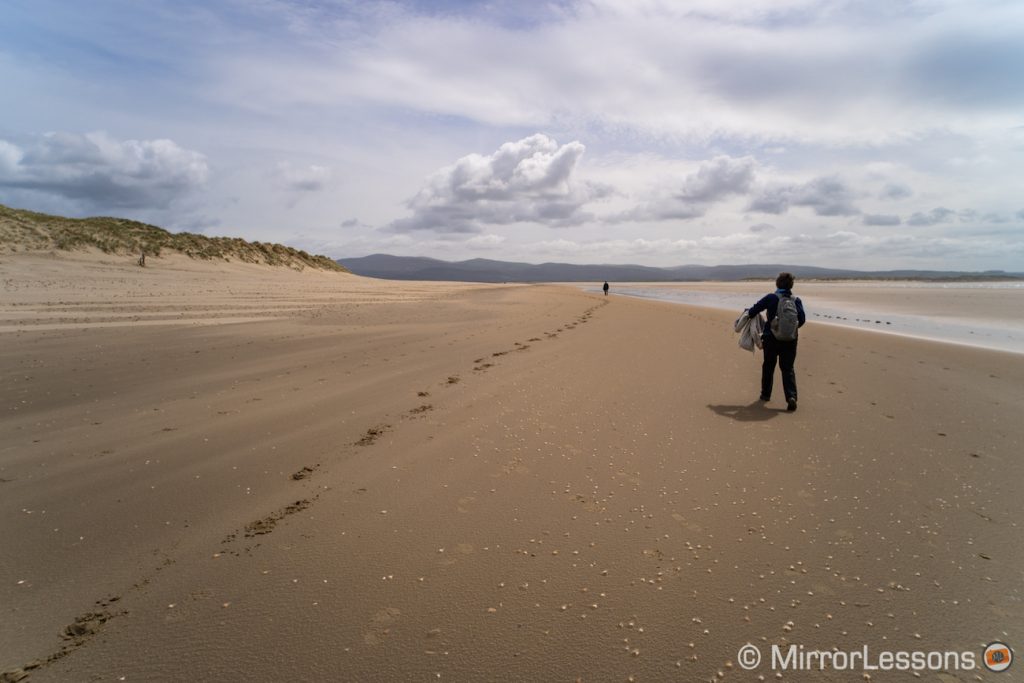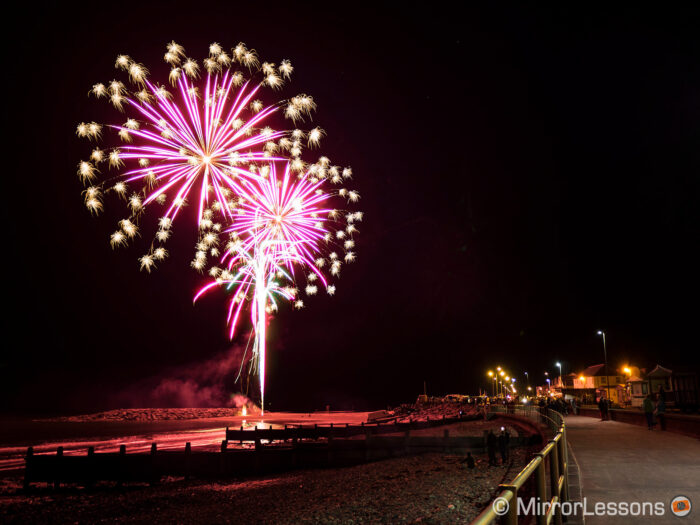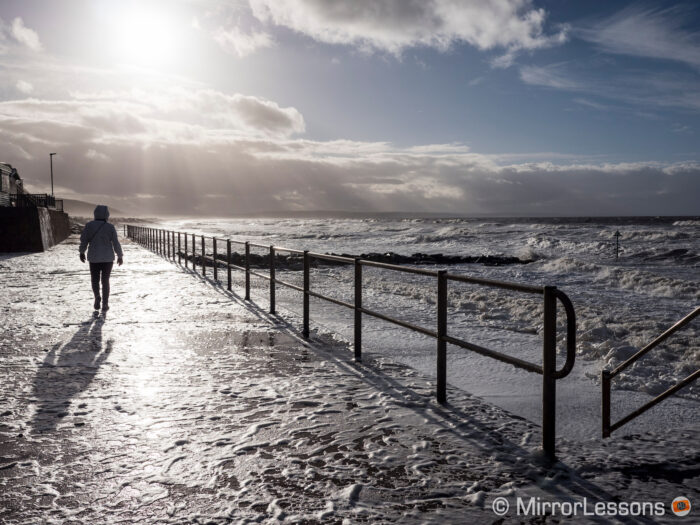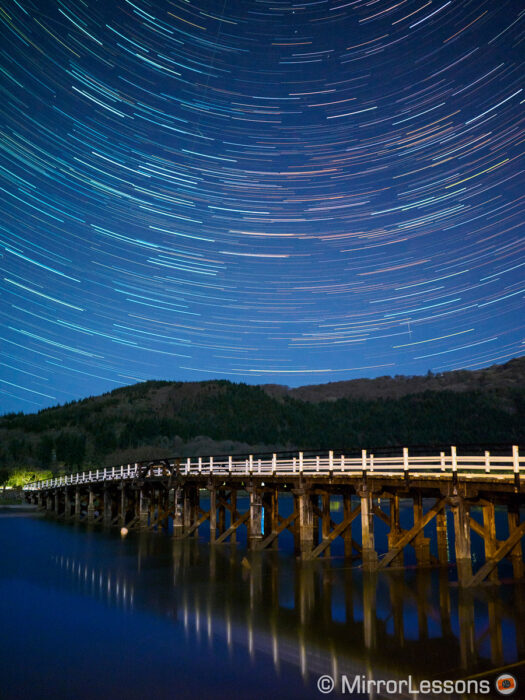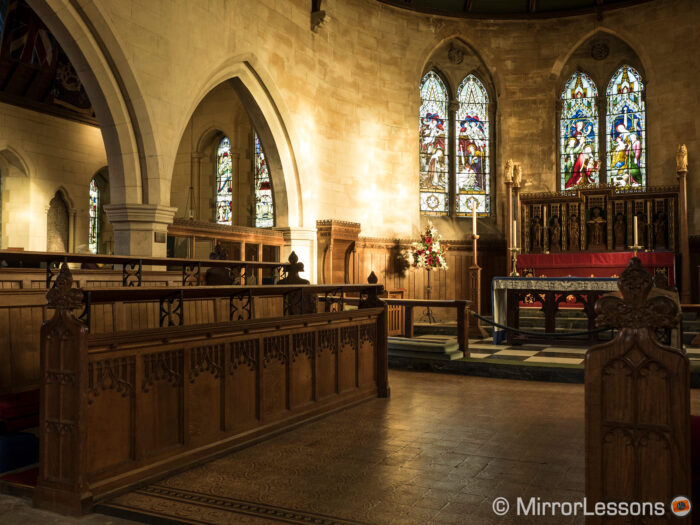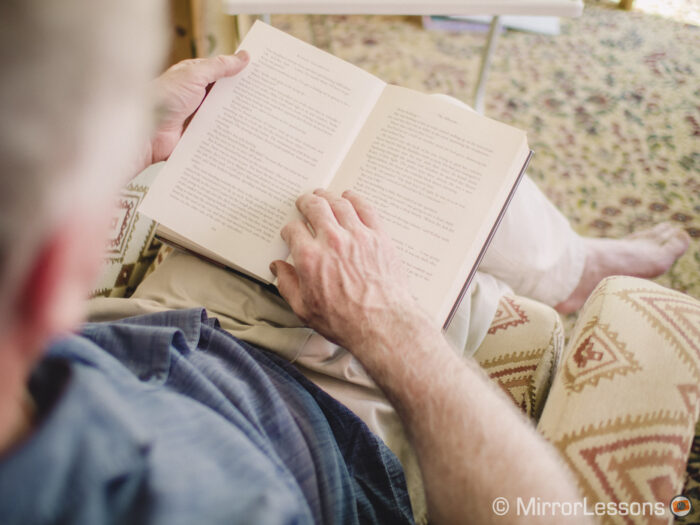You are now on page 2. Here you can find all about wide and moderate wide primes, as well as other products we have excluded or not yet tested and a few words about standard zoom lenses.
Table of contents – Page 1
– Wide-Angle Zoom Lenses
– Fisheye Prime Lenses
– Super-Wide Prime Lenses
Table of contents – Page 2
– Wide Prime Lenses
– Moderate Wide Prime Lenses
– Other products
Wide Prime Lenses for Micro Four Thirds
When we use the term wide lens, it usually refers to focal lengths between 12mm and 18mm (24mm and 36mm equivalent), with angles of view between 84˚and 65˚. Note that I’ve decided to list the lenses close to 17mm in a separate chapter for reasons I explain further down. There are lots of 12mm lenses, each with different characteristics and prices, so most of them deserve to be mentioned.
The fastest: Panasonic Leica DG Summilux 12mm f/1.4 ASPH.
Equivalent field of view in 35mm format: 24mm
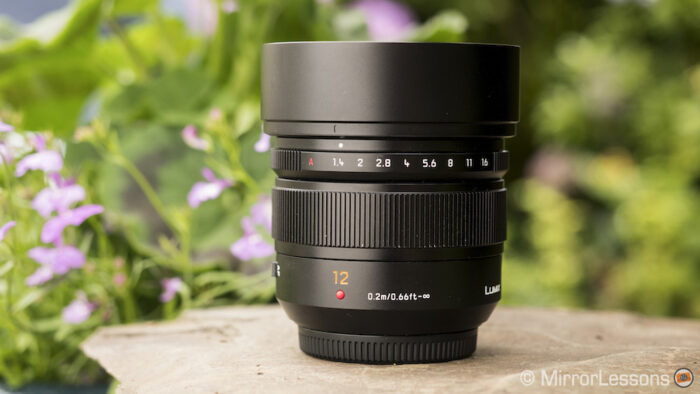
The Leica DG 12mm f1.4 is everything you could want from a premium badged lens. It features an excellent build quality thanks to the metal finish and complete weather sealing. It has a fast and silent focus motor, focus and aperture rings, and an AF/MF switch on the side. If I wanted to nitpick though, I would say that the mechanism of the aperture ring is a bit loose, so you may end up changing values inadvertently.
If you are about to spend this kind of money, you want to make sure that the lens delivers proper optical performance and one thing is for sure: the 12mm is sharp. Right from 1.4 it delivers excellent results which means it becomes an interesting option for low light events, weddings and astro-photography. Distortion and chromatic aberration are a non-issue.
The only disappointment with this lens is flare resistance, which is below what you would expect given the asking price and the Leica premium badge. If you like to work a lot with backlight, you’ll most likely be disappointed.
Why choose the Leica DG Summilux 12mm f/1.4 for your Micro Four Thirds camera:
- premium construction and weather sealing
- fast 1.4 aperture and superb sharpness
To consider:
- lots of flare
- expensive
- the aperture ring doesn’t work on Olympus cameras
Reminder: the links below are affiliate links. If you decided to buy something after clicking the link, we will receive a small commission.
Check price of the Leica DG Summilux 12mm f/1.4 on
Amazon | Amazon UK | B&H Photo | eBay
Our favourite: Olympus M.Zuiko Digital ED 12mm f2
Equivalent field of view in 35mm format: 24mm
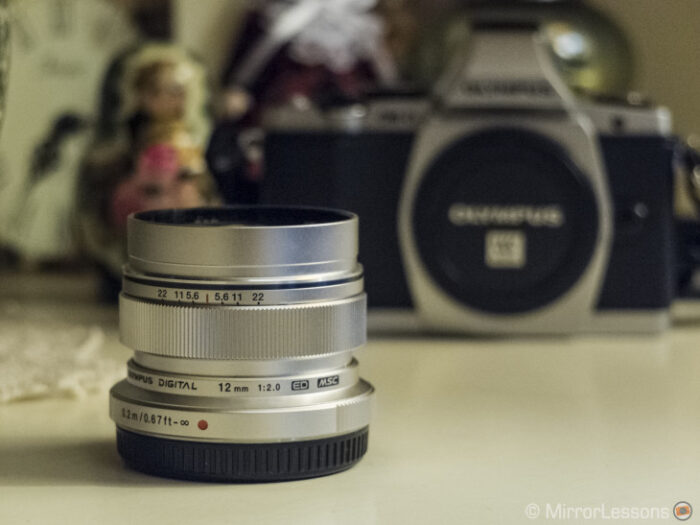
If you like the idea of a 24mm equivalent prime with autofocus but don’t want to spend the money for the Panasonic / Leica model, Olympus has an interesting f2 version. The retail price is still a bit expensive if you ask me, but the lens is eight years old so you can probably find it for less.
The 12mm f2 is the first lens we bought when we started reviewing mirrorless cameras in 2013 (along with the 45mm 1.8 and the OM-D E-M5). It served us well for many years thanks to its compact design, good metal build, fast AF motor and very good optical performance. The corners are a tad softer than the centre but once you stop down to f2.8 or f4, there is no cause for complaint. Flare resistance is good and there is some mild vignetting at the fastest aperture but nothing to be concerned about.
The pull-back focus ring allows you to switch instantly from auto to manual focus and also gives you a better precision than a pure fly-by-wire ring. Be aware that it comes without lens hood.
Why choose the M.Zuiko 12mm f2 for your Micro Four Thirds camera:
- compact metal build
- fast aperture and very good optical performance
- pull-back focus ring
To consider:
- I wish it could be a bit less expensive
- no lens hood provided, no weather sealing
Reminder: the links below are affiliate links. If you decided to buy something after clicking the link, we will receive a small commission.
Check price of the M.Zuiko 12mm f2 on
Amazon | Amazon UK | B&H Photo | eBay
Bang for your buck: Samyang 12mm f/2 NCS CS
Equivalent field of view in 35mm format: 24mm
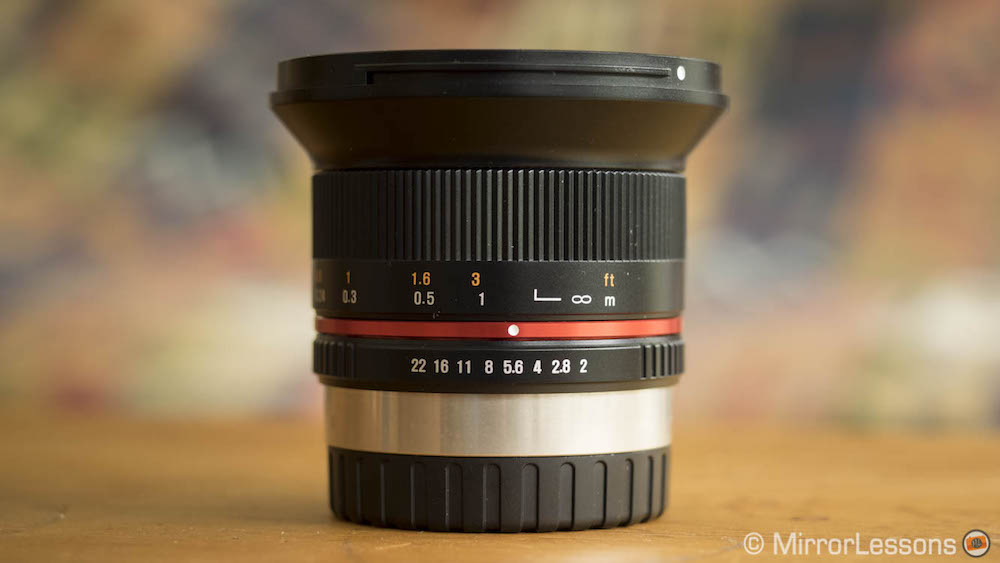
The Samyang 12mm is a popular lens amongst mirrorless APS-C users and for good reason. It has an affordable price and excellent optical performance, including a bright f2 aperture that has made the lens a favourite among astrophotographers. Thankfully a Micro Four Thirds mount version is available too! Like the Laowa products, this is strictly a manual focus lens with no electronic contacts.
The dimensions are compact enough even for small Micro Four Thirds cameras. There is no weather sealing and there are some plastic parts but the lens feels well built. The aperture ring is precise to use and so is the mechanical focus ring. It lacks a hyperlocal scale on the barrel however.
Sharpness is very good at the centre at f2 and the lens peaks between f4 and f5.6. The corners are softer and there is some vignetting, but since the Micro Four Thirds sensors don’t use the entire area of the lens, you won’t notice them as much. Flare resistance is good, distortion is easily corrected in post but chromatic aberration can be a bit tricky to eliminate and I would say this is the lens’ weakest point.
Why choose the Samyang 12mm f/2 for your Micro Four Thirds camera:
- affordable
- excellent sharpness
- good for astro-photography
To consider:
- manual focus only
- chromatic aberration is not always easy to get rid of
Reminder: the links below are affiliate links. If you decided to buy something after clicking the link, we will receive a small commission.
Check price of the Samyang 12mm f2 on
Amazon | Amazon UK | B&H Photo | eBay
The cheapest: 7artisans 12mm f2.8
Equivalent field of view in 35mm format: 24mm
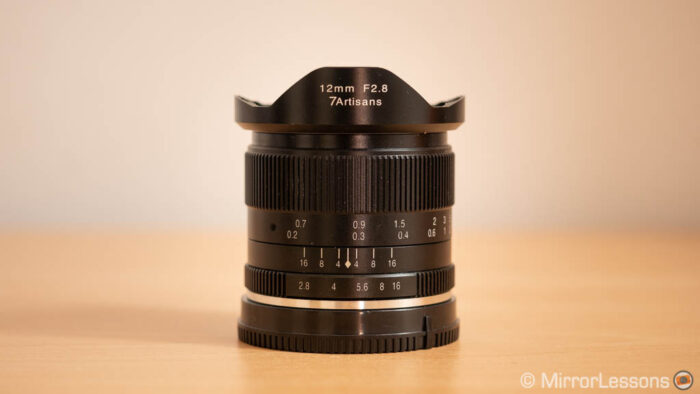
If you want an inexpensive 24mm equivalent lens, then look no further than the 7artisans 12mm f2.8. You may think that cheap equals poor quality but this is not the case!
Sharpness is really good at the centre. On the APS-C sample we tested, the corners were softer but this will be less noticeable on the Micro Four Thirds cameras because the extreme edges of the lens won’t be used. Same goes for vignetting. There is a bit of chromatic aberration and flare if you shoot into direct sunlight, but distortion is contained.
The lens has a good metal build quality but as you can expect, it is manual focus only and there are no electronic contacts. The focus ring is precise but you’ll notice some focus breathing when going from the shortest focus distance to infinity. The aperture ring is click-less but doesn’t show all the aperture values (f11 is missing). Be aware that the plastic lens cap doesn’t lock on well (at least on our copy).
Why choose the 7artisans 12mm f/2.8 for your Micro Four Thirds camera:
- the least expensive option in this list
- good build quality
- fine optical performance considering the price
To consider:
- manual focus lens without EXIF data
- noticeable focus breathing
- fiddly lens cap
Reminder: the links below are affiliate links. If you decided to buy something after clicking the link, we will receive a small commission.
Check price of the 7artisans 12mm f2.8 on
Amazon | Amazon UK | B&H Photo | eBay
One of a kind: Panasonic LUMIX G 14mm f/2.5 ASPH II
Equivalent field of view in 35mm format: 28mm
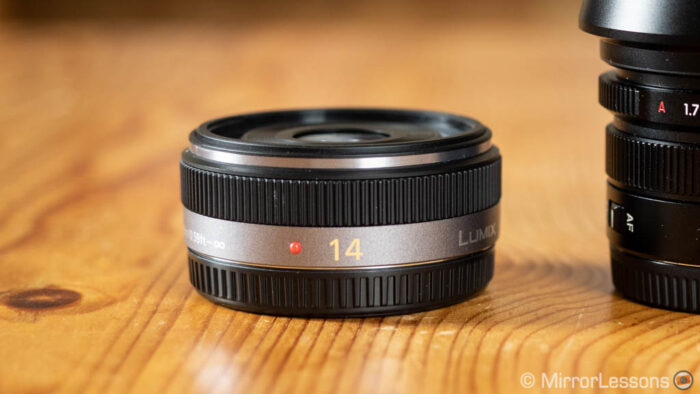
The Lumix 14mm is the only lens on this list that gives you an equivalent field of view of 28mm, which is often a favourite amongst landscape, street or reportage photographers. It is the only 28mm equivalent you can find in the Panasonic/Olympus catalogues.
Is is very tiny due to its pancake design so you can fit it anywhere. It has a plastic finish and is very light (55g). There is no weather sealing. The AF motor is fast but the focus ring doesn’t provide a super smooth experience in comparison to other lenses.
Sharpness is very good at the centre. Corners are a bit softer but they don’t look awful either. The lens has good close-up capabilities which deliver sharp result and a pleasant bokeh despite the not-so-fast aperture. There is a bit of vignetting and chromatic aberration to deal with, as well as flare in direct light.
Why choose the Panasonic 14mm f/2.5 for your Micro Four Thirds camera:
- the only lens with a 28mm equivalent field of view
- super tiny and light
- good optical performance
- very affordable price
To consider:
- corners are a bit soft
- plastic build
Reminder: the links below are affiliate links. If you decided to buy something after clicking the link, we will receive a small commission.
Check price of the Panasonic 14mm f2.5 on
Amazon | Amazon UK | B&H Photo | eBay
Wide Prime Lens Comparisons
If you want to see how some of these lenses compare side by side, check out the following articles:
Moderate Wide-Angle Primes
Moderate is not a technical term, but I wanted to separate the least wide lenses from the wide-angle category because they can be used for different purposes.
Although they work perfectly fine for landscapes, they might be too narrow for interiors, astro-photography or architecture if your priority is to capture the entire scene. If you concentrate on specific portions of the frame however, they can work well because they all offer excellent optical quality. These lenses are also very popular for street photography, weddings, reportage and environmental portraits.
Our favourite: Panasonic Leica DG Summilux 15mm f/1.7 ASPH.
Equivalent field of view in 35mm format: 30mm
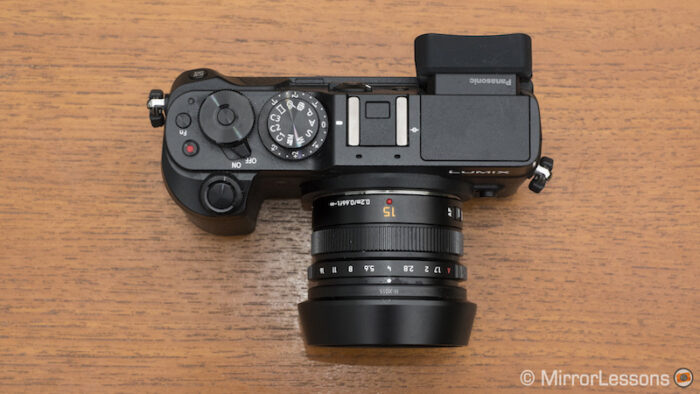
The Leica DG 15mm has an odd angle of view of 72˚ but the optical quality is stunning. In fact I would say it is one of the very best on this list.
Sharpness is excellent across the frame right from f1.7, while the close focus capabilities allow you to play with shallow depth of field and achieve a nice bokeh. Flare resistance is excellent, vignetting and distortion are quite contained but you’ll come across some chromatic aberration at the fastest aperture in scenes with strong contrast and backlight.
The lens is extremely small, light and compact. There is a clicking aperture ring (sadly it only works with Panasonic cameras), a MF/AF switch and it boasts a premium metal build. The AF motor is really fast and smooth. It only lacks weather resistance.
Why choose the Leica DG Summilux 15mm f1.7 for your Micro Four Thirds camera:
- optical quality at its finest
- fast aperture
- premium build quality
To consider:
- no weather resistance
- aperture ring is ineffective with Olympus cameras
Reminder: the links below are affiliate links. If you decided to buy something after clicking the link, we will receive a small commission.
Check price of the Leica DG Summilux 15mm f1.7 on
Amazon | Amazon UK | B&H Photo | eBay
Best value for money: Sigma 16mm f/1.4 DC DN | C
Equivalent field of view in 35mm format: 32mm
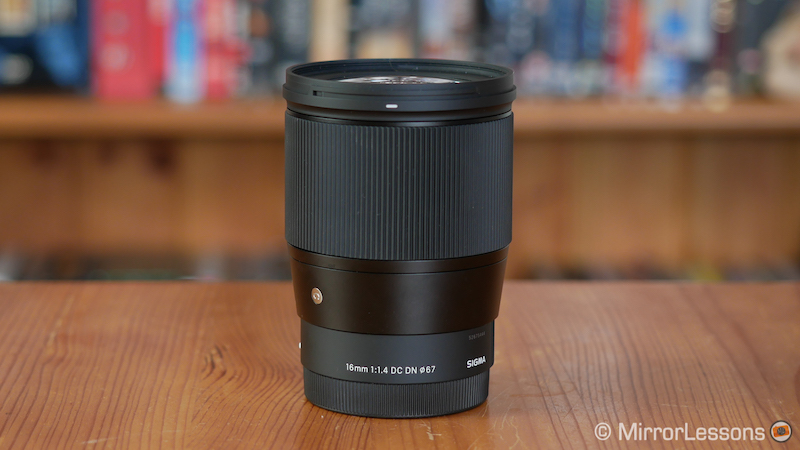
Designed for APS-C cameras, the Sigma 16mm is another lens that gives you a less common angle of view, but it comes at an attractive price and delivers excellent optical performance, reaching optimal results at f2. The corners are slightly softer but once again this will be a minor issue on Micro Four Thirds.
The bokeh is very pleasant when focusing close and the lens has good subject separation capabilities. There is a bit of moustache distortion, some chromatic aberration at the fastest apertures as well as flare in direct light.
The lens focuses fast on Micro Four Thirds cameras and the large ribbed focus ring is very nice to use. The mount is sealed but the rest of the lens isn’t. Finally we have the size, which might be the only thing that puts you off if you’re looking for a compact solution.
Why choose the Sigma 16mm f/1.4 for your Micro Four Thirds camera:
- competitive price
- excellent optical quality
- fast aperture and nice subject separation
To consider:
- light but large
- slight moustache distortion
Reminder: the links below are affiliate links. If you decided to buy something after clicking the link, we will receive a small commission.
Check price of the Sigma 16mm f/1.4 on
Amazon | Amazon UK | B&H Photo | eBay
The cheapest: Olympus M.Zuiko Digital 17mm f/1.8
Equivalent field of view in 35mm format: 34mm
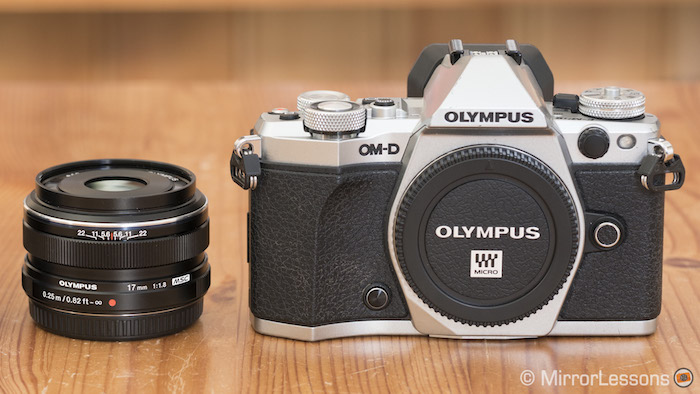
When we compared the 17mm 1.8 to the Panasonic/Leica 15mm 1.7, we concluded that the latter was preferable for many reasons given the similar price tag. Today though, the Olympus lens can be found for less and therefore it deserves a mention.
Centre sharpness, while not reaching the same level as the 15mm or the 17mm 1.2 Pro, is good enough for many applications. The corners suffer more at the fastest apertures but are fine once stopped down to f4. Flare resistance is very good, but you’ll come across some chromatic aberration in high contrast situations at the fastest apertures. There is a bit of distortion and bokeh fringing at 1.8.
The main advantage of such a lens is the very compact design, and I love the sliding focus ring that is found on many Olympus lenses. It has a nice metal build but no weather sealing and here as well, the hood is not included in the box. But as long as the price remains cheap, it is worth considering.
Why choose the Olympus 17mm f/1.8 for your Micro Four Thirds camera:
- good sharpness at the centre (and the corners when stopped down)
- tiny and light
- pleasant metal build and sliding focus ring mechanism
To consider:
- worth choosing over the Panasonic/Leica 15mm if the price difference is significant
Reminder: the links below are affiliate links. If you decided to buy something after clicking the link, we will receive a small commission.
Check price of the Olympus 17mm f/1.8 on
Amazon | Amazon UK | B&H Photo | eBay
The very best: Olympus M.Zuiko Digital ED 17mm f/1.2 PRO
Equivalent field of view in 35mm format: 34mm
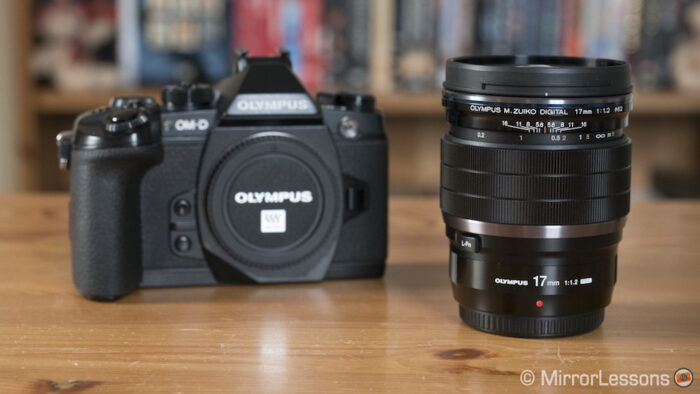
If you’re not afraid to invest a larger sum of money and want the very best lens the system has to offer in this field of view range, then the 17mm 1.2 Pro is it. This lens ticks all the boxes except compactness, but we can’t really blame the designers given the characteristics.
Sharpness is spot on from the fastest aperture at the centre and in the corners. At this value, it isn’t far off peak performance which occurs at around f2. You also get a very pleasant bokeh and excellent subject separation. Distortion is very well controlled so the lens can be used for architecture without any issues. There can be a bit of flare, vignetting and chromatic aberration at the fastest aperture but it’s nothing to worry about.
Like all the Pro lenses, the build quality is superb with full weather sealing, a pleasant focus ring that can be pulled back to focus manually, and a programmable function button. Of course it is expensive, but worth considering if you want the absolute best.
Why choose the Olympus 17mm f/1.2 Pro for your micro four thirds camera:
- optimal sharpness from 1.2
- superb optical performance and no distortion
- high quality build with weather sealing
To consider:
- expensive, as you can imagine
Reminder: the links below are affiliate links. If you decided to buy something after clicking the link, we will receive a small commission.
Check price of the Olympus 17mm f/1.2 Pro on
Amazon | Amazon UK | B&H Photo | eBay
A different look: Voigtländer Nokton 17.5mm f/0.95
Equivalent field of view in 35mm format: 35mm
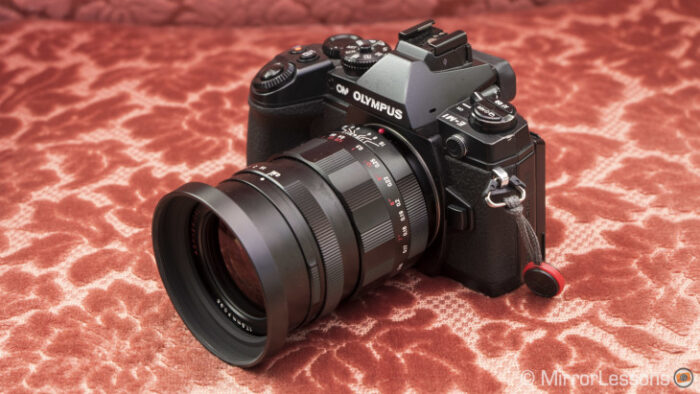
I almost didn’t include this lens on the list, but that would have been a bit unfair given the unique characteristics this Nokton has to offer. Like the 10.5mm, the 0.95 aperture coupled with Voigtländer’s distinctive colour rendering and bokeh gives your images a different look. It is not as sharp, contrasty or precise as modern digital lenses, but this might be exactly what you are looking for.
There are compromises: the 0.95 aperture can give you some ethereal / dreamy images when focusing close which you won’t get with many lenses in the Micro Four Thirds system, but the lack of detail is noticeable. In fact this lens starts to peak from 2.8. Stop it down to around f11 or f16 and it produces amazing sunstars in backlit situations, making it another favourite among Voigtländer aficionados.
It’s manual focus only, and doesn’t have electronic contacts or weather sealing. The lens is quite heavy too, but the mechanical focus ring is a joy to use and the aperture ring can be de-clicked for video use.
It is not a cheap lens, although the price has come down a little, but the same can be said about the 17mm 1.2 Pro (when on offer) and the latter offers relevant advantages such as better sharpness and a very fast autofocus. So really it is about that distinctive look and accepting some compromises.
Why choose the Voigtländer 17.5mm f/0.95 for your micro four thirds camera:
- unique characteristics and look
- fast 0.95 aperture gives unique shallow depth of field results at close distances
- lovely mechanical focus ring
To consider:
- heavy
- sharpness doesn’t peak before f2.8
Reminder: the links below are affiliate links. If you decided to buy something after clicking the link, we will receive a small commission.
Check price of the Voigtländer 17.5mm f/0.95 on
Amazon | Amazon UK | B&H Photo | eBay
Moderate Wide Prime Lens Comparisons
If you want to see how some of these lenses compare side by side, check out the following articles:
- Panasonic Leica 15mm 1.7 vs Olympus 17mm 1.8
- Panasonic Leica 15mm 1.7 vs Lumix 14mm 2.5
- Sigma 16mm 1.4 vs Olympus 17mm 1.8
- Olympus 17mm 1.2 vs 17mm 1.8
Other products
There are other manual focus lenses and recent products that we haven’t had the chance to test yet, or that we’ve decided to exclude. Here is a quick list with a short explanation for each product.
- Laowa 4mm f2.8 Fisheye: recently announced, it offers a circular perspective with a 210˚ angle of view. Not yet tested, and I admit I’m not keen on circular fisheyes (but that’s just me). It’s cheap though.
- 7Artisans 7.5mm f2.8 Fisheye: designed for APS-C format, it is also available with a m4/3 mount but we haven’t tested it yet.
- Kowa Prominar 8.5mm f2.8: I saw this lens at the Photography Show in Birmingham 5 years ago but never got the chance to test a full production sample. The 17mm equivalent field of view is interesting but now that the smaller Laowa 9mm is out, I see little reason to get this one, especially considering the high price.
- Kowa Prominar 12mm f1.8: here as well, there is already a vast choice of fast 12mm lenses and the old, large and expensive manual focus Kowa lens offers too little to be attractive.
- Meike 6.5mm f2 Fisheye: an interesting combination of fast aperture and very wide fisheye lens, but we haven’t tested it. There is also an 8mm f3.5 but it is designed for DSLRs, and is therefore larger.
- Meike 12mm f2.8: another 12mm manual focus lens designed for APS-C but it doesn’t make sense to list them all. Plus the 7artisans performs better.
- Panasonic 8mm f3.5 Fisheye: another one we haven’t tried is the first fisheye designed for the system (if my memory serves me well). It’s almost double the price of the Samyang, but you get autofocus.
Standard Zoom Lenses
Standard zoom lenses, whether premium or kit, start from 12mm or 14mm. This gives you an equivalent angle of view of 24/28mm which gives you lots of flexibility if you’re interested in landscapes or architecture. Of course you don’t get the extreme view shorter focal lengths can deliver, but you have a longer reach when zooming in.
My favourite is the Olympus 12-40mm f2.8 Pro, one of the lenses I’ve used the most since I bought it in 2014. There is also a Panasonic/Leica 12-60mm f2.8-4, as well as an excellent Lumix G 12-60mm f3.5-5.6 kit lens. Smaller / cheaper zooms and pancake zooms are also available (14-42mm, 12-32mm). Below you can check out some comparisons between these standard zooms:
- Olympus 12-40mm f2.8 Pro vs Leica DG 12-60mm f2.8-4
- Olympus 12-40mm f2.8 Pro vs 12-100mm f4 Pro
- Olympus 12-40mm f2.8 Pro vs 12mm f2
- Leica DG 12-60mm f2.8-4 vs Lumix G 12-60mm f3.5-5.6
There is also the Panasonic 10-25mm f1.7. I’ve only seen a pre-production version of this lens so far. It starts from 10mm (20mm equivalent), giving you a wider angle of view than other standard zooms. It’s large, heavy and the very expensive but early reviews are praising its optical quality. I hope to test it soon.
Table of contents – Page 1
– Wide-Angle Zoom Lenses
– Fisheye Prime Lenses
– Super-Wide Prime Lenses
Table of contents – Page 2
– Wide Prime Lenses
– Moderate Wide Prime Lenses
– Other products

